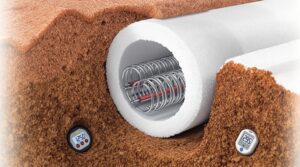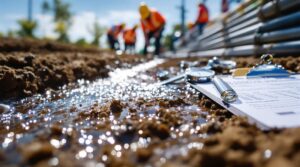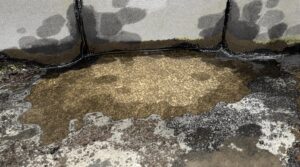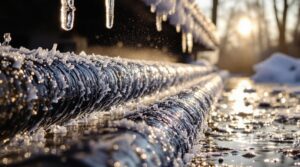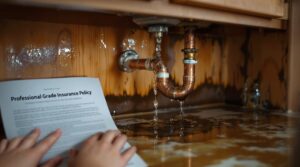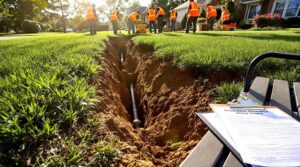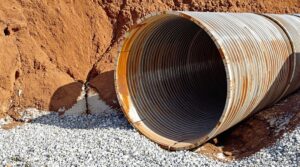Underground water line repair involves systematic assessment of issues through signs like unexplained puddles, increased water bills, and reduced pressure. Professional repairs require essential tools including excavation equipment, pipe cutters, and safety gear. Proper techniques demand utility line marking, controlled excavation, and appropriate pipe materials such as HDPE or copper. Testing includes pressure checks and leak detection, followed by careful restoration. Working with public adjusters can maximize insurance claim settlements for thorough repairs.
Key Takeaways
- Watch for warning signs like unexplained puddles, high water bills, reduced pressure, ground erosion, or unusual plumbing sounds.
- Contact utility companies to mark underground lines before excavating and use hand digging near existing utilities.
- Choose appropriate repair materials like HDPE or copper pipes, and ensure proper tools and safety equipment are available.
- Perform thorough testing after repairs, including water flow checks and pressure testing before backfilling the excavation.
- Consider hiring licensed public adjusters to maximize insurance claim settlements and ensure proper documentation of repairs.
Essential Tools and Safety Equipment
When undertaking underground water line repairs, having the right tools and safety equipment is essential for both efficiency and worker protection. A thorough toolkit for water supply line repairs should include basic excavation tools like a shovel and pickaxe, along with specialized tools such as tubing cutters, hacksaws, and reciprocating saws for precise pipe repair work.
Professional-grade pliers and wrenches are necessary for securing fittings, while Teflon tape and thread sealant guarantee watertight connections.
At the excavation site, proper safety equipment is non-negotiable. Workers must wear appropriate protective gear including gloves, safety goggles, and hard hats to guard against potential hazards encountered during underground repairs.
Before beginning any excavation work, contractors must verify local regulations and obtain necessary permits. This preparation, combined with the right tools and safety equipment, creates a foundation for successful underground water line repairs while maintaining compliance with safety standards.
Signs of Underground Water Line Problems
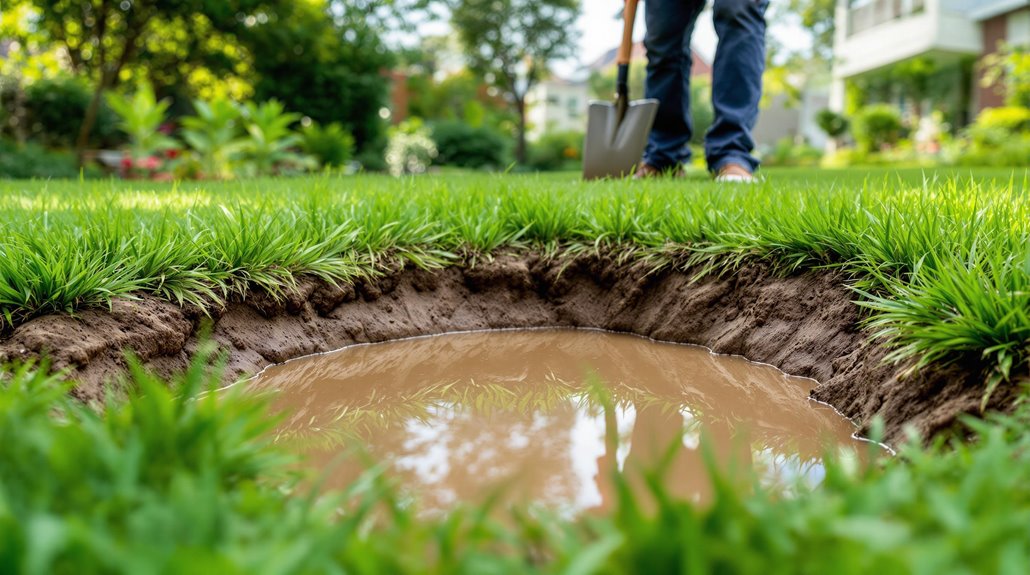
Since underground water line issues can cause significant property damage and costly repairs, recognizing early warning signs is essential for homeowners and property managers.
Several indicators can signal problems with underground water lines. Unexplained puddles in the yard or persistent wet spots may reveal leaking water from damaged pipes below the surface. A sudden spike in water bills without changes in consumption patterns often indicates hidden leaks requiring immediate attention.
Reduced water pressure throughout the property can stem from blockages or structural damage to pipes. Property owners should monitor for visible erosion or ground cracking near known water line locations, as these symptoms suggest underground leakage.
Additionally, unusual sounds like hissing or gurgling from plumbing fixtures may indicate air entering the system through compromised pipes. Regular inspections and prompt investigation of these warning signs can prevent extensive damage and minimize repair costs while maintaining the integrity of underground water lines.
Proper Excavation Techniques
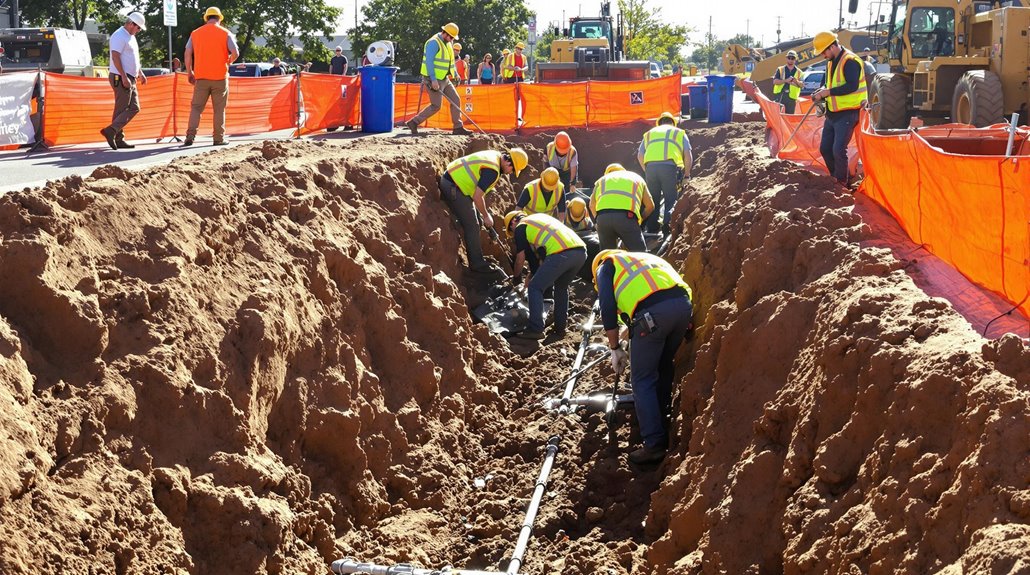
Once underground water line problems are identified, proper excavation techniques must be implemented to access and repair the affected areas safely.
The process begins with a thorough site assessment using advanced detection tools to locate existing underground utilities. Before any digging commences, local utility companies must be contacted to mark utility line locations.
The excavation process requires careful attention to safety protocols and precise methods. Hand digging is vital near existing utilities to prevent accidental damage. The soil should be removed in controlled layers, with proper compaction during backfilling to maintain structural integrity and prevent future settling around the repaired water line.
To protect workers from soil collapse and create a secure working environment, the excavation site must be stabilized using appropriate safety equipment such as shoring and trench boxes. These measures guarantee both worker safety and the successful completion of underground water line repairs.
Pipe Repair Methods and Materials
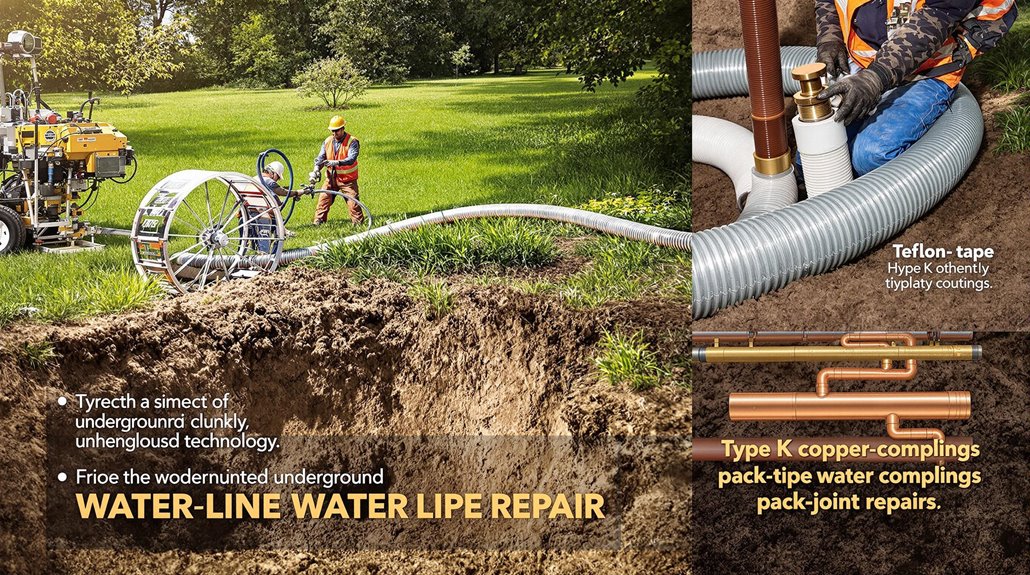
Professional pipe repair for underground water lines demands specific methods and high-quality materials to guarantee lasting solutions. Common pipe repair methods include traditional cut-and-replace techniques, coupling installations, and trenchless technology, which minimizes excavation requirements.
The selection of durable materials plays an important role in ensuring longevity. High-density polyethylene (HDPE) pipes have become increasingly popular due to their flexibility and corrosion resistance, offering a service life exceeding 50 years. For applications requiring maximum durability, Type K copper pipe remains a trusted choice, particularly when combined with pack-joint couplings for outdoor connections.
Proper installation requires careful attention to detail, including the application of Teflon tape or thread sealant on threaded fittings and silicone caulk around entry points to prevent water infiltration. Before completing any underground water line repair, conducting a thorough leak test is essential to verify the repair's integrity and prevent future complications.
Testing and Restoration Procedures
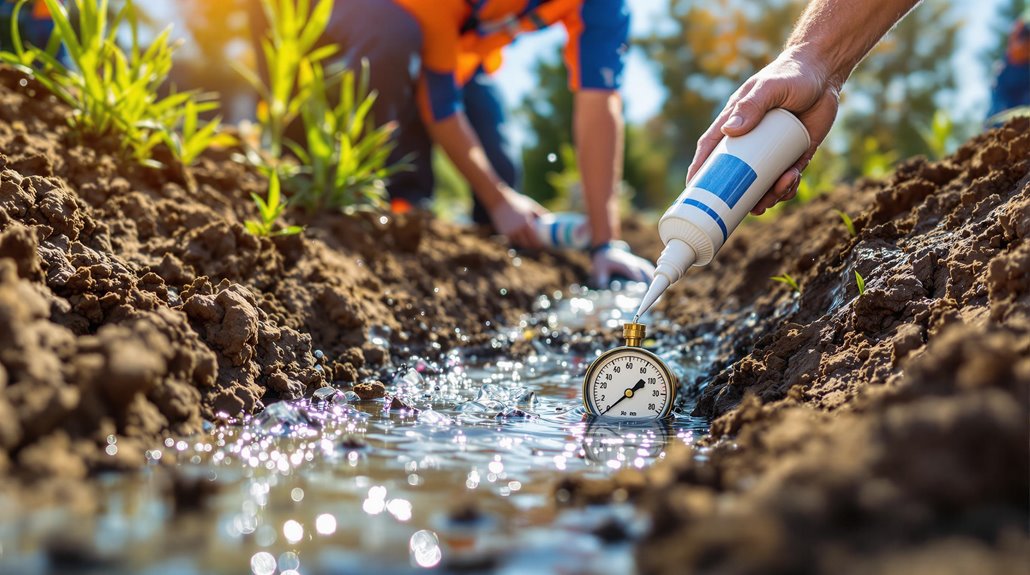
Thorough testing and restoration procedures form the cornerstone of successful underground water line repairs. After completing repairs, technicians must conduct extensive leak testing by restoring water flow and inspecting for any signs of seepage around the repaired area. Pressure testing confirms proper system operation and pipeline integrity.
| Phase | Testing Procedure | Restoration Step |
|---|---|---|
| Initial | Water flow check | Layer backfilling |
| Secondary | Pressure testing | Soil compaction |
| Tertiary | Entry point inspection | Sealant application |
| Quaternary | System operation verification | Ground leveling |
| Final | Visual assessment | Landscape repair |
The restoration process involves methodically backfilling the excavated site while ensuring proper soil compaction to prevent future settling. Critical attention must be given to sealing pipe entry points, typically using silicone sealant around PVC sleeves. The final phase includes landscape restoration, addressing disturbed areas through reseeding or concrete patching to maintain site aesthetics and prevent soil erosion.
The Benefits Of Consulting A Public Adjuster
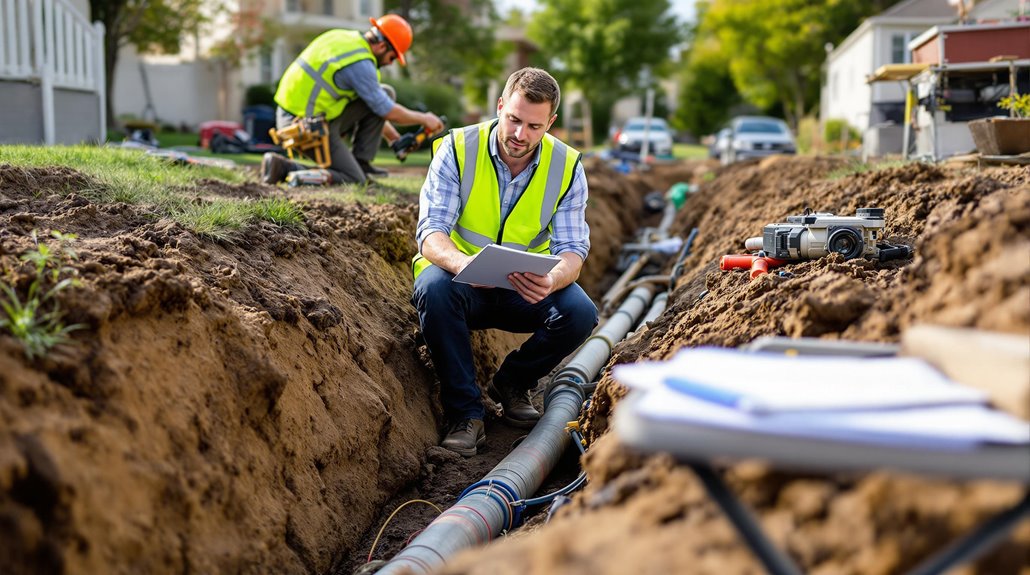
Professional public adjusters offer specialized expertise in underground water line insurance claims, providing objective damage assessments and detailed documentation that strengthen the policyholder's position.
Their involvement streamlines the complex claims process by managing all interactions with the insurance company and ensuring proper coverage interpretation.
Studies indicate that claims handled by public adjusters typically result in markedly higher settlements, with payouts up to 800% more than those processed without professional representation.
Expertise In Insurance Claims
Partnering with a public adjuster during an underground water line insurance claim can substantially improve settlement outcomes for homeowners. Their expertise in interpreting policies and evaluating water damage guarantees extensive documentation of all repair costs and associated damages.
- Professional adjusters secure 20-50% higher settlements compared to homeowner-filed claims.
- Licensed experts provide thorough documentation and damage assessments.
- Adjusters manage all insurance company communications and negotiations.
- Claims process acceleration through professional documentation methods.
Public adjusters bring specialized knowledge to complex underground water line claims, offering homeowners expert guidance through intricate policy terms and coverage rights.
Their systematic approach to damage evaluation, combined with their negotiation experience, maximizes claim settlements while reducing the stress and time investment required from property owners during the claims process.
Objective Damage Assessment
Independent damage assessment from a public adjuster provides property owners with an unbiased evaluation of underground water line issues, establishing a thorough foundation for insurance claims.
Through expert evaluations, public adjusters identify hidden damage that may escape untrained observation, including internal corrosion and structural complications that could impact long-term repair costs.
Working on a contingency fee basis, these professionals conduct extensive damage assessments that document all aspects of water line deterioration.
Their systematic approach guarantees that no potential issues are overlooked during the claims process.
Streamlined Claim Process
Beyond thorough damage assessment, public adjusters provide invaluable support by streamlining the complex insurance claims process for underground water line repairs.
Their expertise helps property owners navigate insurance policies while maximizing claim potential through professional representation.
Key benefits of engaging a public adjuster include:
- Expert management of documentation and communication with insurance companies, ensuring accurate submission of all required paperwork
- Higher settlement potential through precise damage assessment and skilled negotiation techniques
- Professional interpretation of policy terms and conditions to enhance coverage utilization
- Accelerated claims processing, enabling faster repairs and property restoration
Operating on a contingency fee basis, public adjusters align their compensation with the homeowner's interests, working diligently to secure favorable settlements while expediting the entire claims process.
Higher Claim Payouts & Settlements
Public adjusters substantially enhance the financial outcome of underground water line repair claims through their specialized expertise and strategic negotiation skills. Statistical data indicates they can increase claim settlements by 20-50% through accurate damage assessments and effective negotiating with insurers.
Their thorough understanding of insurance policies enables them to identify coverage gaps and secure additional compensation for costly repairs.
Working on contingency, public adjusters are motivated to maximize settlements for water line replacement projects. They streamline the claims process by managing documentation and leveraging industry relationships to advocate for full coverage of the damaged area.
Their expertise in estimating damages ensures all repair aspects are properly valued and documented. This professional representation often results in higher payouts while reducing the policyholder's time investment and stress during complex underground water line claims.
About The Public Claims Adjusters Network (PCAN)

The Public Claims Adjusters Network (PCAN) represents a nationwide coalition of state-licensed public adjusters who have undergone rigorous vetting and verification processes. Operating in over 40 states, PCAN connects policyholders with expert assistance for property damage insurance claims through their network of professional services providers who maintain the highest standards in the industry.
Key aspects of PCAN's operations include:
- Mandatory yearly audits of licenses and complaint records for all member adjusters
- Coverage for more than 30 different types of property damage claims
- Intensive application and interview process for potential member adjusters
- Strict adherence to ethical and professional standards
PCAN serves as a critical resource for property owners seeking pre-vetted, licensed adjusters who specialize in maximizing insurance claim settlements.
Their member adjusters must demonstrate exceptional expertise in their field while maintaining impeccable professional credentials to remain part of the network.
Frequently Asked Questions
How Do You Fix a Broken Underground Water Line?
Like a surgeon healing wounds, technicians detect water leaks, shut off supply, excavate carefully, remove damaged sections, install new piping with proper fittings, test pressure, and restore landscaping.
How Much Does It Cost to Fix a Broken Water Pipe Underground?
Underground water pipe repairs typically cost $3,000-$10,000, varying by repair methods, pipe materials, location accessibility, and labor rates. Emergency repairs and extensive leak detection may increase expenses markedly.
Does Homeowners Insurance Cover Broken Underground Water Pipes?
Standard insurance policies typically cover sudden water damage from broken underground pipes but exclude the pipe repair itself. Coverage limits vary, and specific endorsements may be needed for thorough protection.
Can I Fix My Own Water Line?
DIY water line repairs require proper tools, knowledge of local regulations, and understanding of soil conditions. While minor repairs are possible, complex issues demand professional expertise for safety and compliance.
